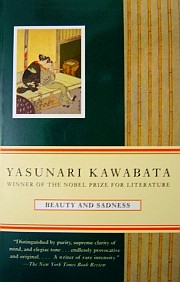Beauty and Sadness
 Beauty and Sadness (1975) is the last novel written by Nobel Prize-winning Japanese author Yasunari Kawabata, and it was published after his death in 1972. The novel is translated from Japanese by Howard Hibbett.
Beauty and Sadness (1975) is the last novel written by Nobel Prize-winning Japanese author Yasunari Kawabata, and it was published after his death in 1972. The novel is translated from Japanese by Howard Hibbett.In the beginning of the novel, we see aging author Oki Toshio traveling to Kyoto by train. He wants to be there at Kyoto during the New Year's Eve to hear the living sound of the old temple bells. But his real intention behind this trip is to meet Otoko Ueno, with whom he was in love twenty years back.
Oki was a married man in his thirties when he first met Otoko, who was a young girl of sixteen that time. After a brief relationship between them, Otoko becomes pregnant. The child dies during birth, and Oki finds himself unable to marry Otoko. After few months in a psychiatric ward, Otoko, with her mother, shifts to Kyoto. It had been twenty years after that. Oki is now an established writer, with his most popular novel being A Girl of Sixteen, which was based on his own relationship with Otoko. From a magazine, Oki comes to know that Otoko is now a painter and is living near an old temple at Kyoto.
Otoko never had hatred towards Oki. She had learned a lot in Life during twenty years, and it is from A Girl of Sixteen that she actually learns more about Oki and his thoughts during the days of their acquaintance. She had started looking at her relationship with Oki from a philosophical angle, and thinks that the thoughts are purifying her. She doesn't want to admit that she still loves him. She also wonders whether her love for Oki, her mother, and her pupil Keiko are just forms of self-love.
Oki meets Otoko and they together hear the temple bells ringing. But Otoko disappoints him as she doesn't meet him alone, but along with two geishas and Keiko, who stays with her.
The old love affair between Oki and Otoko goes to the background and Keiko, a complex character herself, becomes the main character of the novel, as she decides to take revenge for her mentor. Her targets are Oki as well as his son, Taichiro. And for revenge, she has her own unique plans. But the reader (at least I) is left confused regarding what her real intentions are.
Beauty and Sadness has brilliant portrayals of the five main characters appearing in the novel - Otoko, Keiko, Oki, Taichiro, and Fumiko, Oki's life. It also gives glimpses of Japan's life and landscapes. Along with the main theme, there are few intriguing references to other stories, like that of Princess Kazunomiya. During some excavations, workers of a museum open the tomb of the princess, and they find a little glass plate between the arms of the skeleton of the princess. It turned out that the glass plate was a kind of photograph, and a worker examining it against sunlight saw the figure of a young man on it; but it quickly faded away. Was the princess buried holding a photograph? Who was there in the photograph, was it her husband or lover? Had she asked her maid to keep the glass plate in between her hands secretly when she was dying, hoping to have her lover with her during her death? Kawabata leaves the characters and readers wondering about these matters. And when Fumiko feels sad for the princess's skeleton being "lonely" without the photograph, an unknown sadness comes over us.


0 Comments:
Post a Comment
<< Home